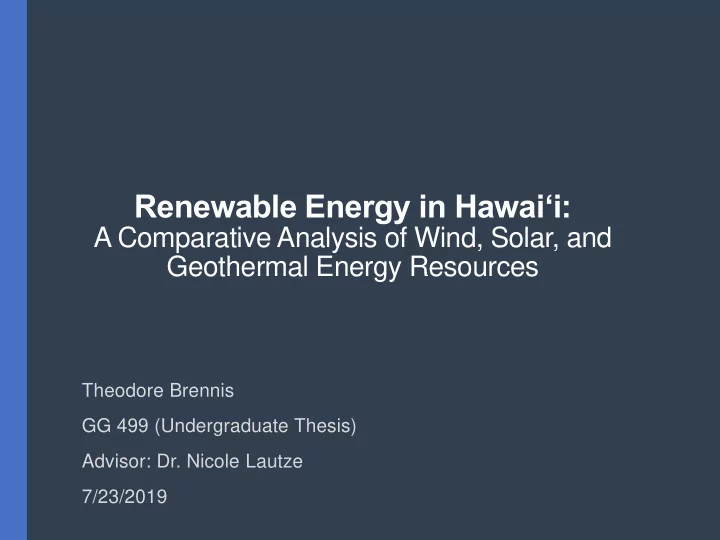

Renewable Energy in Hawaiʻi: A Comparative Analysis of Wind, Solar, and Geothermal Energy Resources Theodore Brennis GG 499 (Undergraduate Thesis) Advisor: Dr. Nicole Lautze 7/23/2019
Outline • Project Methodology • Background Power Supply Improvement Plan (PSIP) Renewable Energy Forecast for Hawaiʻi • Renewable Energy Basics Energy jargon Overview of major renewables in the PSIP • Findings – Renewable Energy Comparisons Land use Cost Geothermal hazards • Final Thoughts
Project Methodology Compare the land use, cost and hazards of three hypothetical renewable resources with similar power delivery capabilities using PGV as the model for comparison VectorStock.com/19426198 | VectorStock.com/1848158 | VectorStock.com/24545938
Hawaiian Electric Company Power Supply Improvement Plan • Hawaiʻi Clean Energy PSIP Power Generation & Initiative (HCEI) set goal to Storage Expansion for Hawai'i 2020-2045 (MW) achieve 100% renewables 157 by 2045 60 1500 MW 300 Geothermal • Plan developed by Hawaiian Potential? 1252 Electric (HECO) and published in the Power 3394 Supply Improvement Plan (PSIP) 2032.74 • PSIP development was collaborative – NREL 80 Onshore Wind Offshore Wind • PSIP review process was LNG Solar exhaustive Geothermal Battery Storage Biomass
Energy Jargon • kW vs kWh → rate vs quantity • Watt = 1 Joule / second → time included • When time is added as suffix → quantity • kWh • MWh Joules • GWh • GWy 1 kWh = for 24 hours
Energy Jargon • Nameplate Capacity: maximum electricity output • Capacity Factor: percent of maximum output for a year Measure of the efficiency of a power plant ➢ Powerplants usually publicly owned & financed ➢ Sell more product (power) pay back debt & earn profit faster • Baseload Energy: minimum power required over a given period Wind and solar cannot provide baseload energy – at some point, due to season or time of day, most renewables will not generate any electricity Major challenge with implementation of Hawai’i’s PSIP PSIP answer: lots of battery storage
Baseload Energy & Capacity Factor
157 60 300 1252 3394 2032 .74 Solar Energy 80 • Electromagnetic radiation used to excite electrons and induce voltage • Capacity factor: 20 – 25% • Land use: 5 – 10 acres/MW EE Waianae Solar Project LLC • Hazards: Silica sand mine in Ottawa, IL Solar cells are made with Alex Garcia, Chicago Tribune, Nov. 20, 2013 silicon purified from high grade quartz which requires mining A Single 4” solar wafer requires 0.77 kWh of energy and 8.9 grams of hazardous production chemicals
This solar farm likely required ≈ 70,000 gallons of chemicals 25,000 MWh of electricity EE Waianae Solar Project LLC
157 60 300 1252 3394 2032 .74 Wind Energy 80 • Kinetic energy in air used to spin turbines and generate electricity • Capacity factor: 35 – 45% • Land use: 30 -113 acres/MW • Hazards: 2 MW turbine requires 700 tons of concrete which releases 500 – 700 tons of CO 2 364 MW of wind on Oahu will release similar volume of CO 2 as 20,000 passenger cars over a year Uncharacterized ecological and health impacts Kaheawa Wind Farm
157 60 300 1252 3394 2032 .74 Liquid Natural Gas 80 • Chemical energy in hydrocarbons used to generate heat and spin turbines • Capacity factor limited only by demand • Generating capacity Schofield Generating Station generally an order of magnitude greater than renewable resources • Hazards Combustion emits CO 2 Storage and transportation Water consumption
157 60 300 PGV 1252 3394 2032 .74 Geothermal 80 • Heat from the earth channeled to the surface with water and used to spin turbines • PGV: 38 MW installed capacity • 322,609 MWh in 2017 • Capacity factor: PGV: 97% in 2017 General: 70-75% Puna Geothermal Venture • Land use: PGV: 1 acre/MW General: 1-8 acres/MW • Hazards: Blowouts and H 2 S Drilling Motive fluids Noise
Renewable Energy Comparison: Land Use • PGV produced 322,609 MWh in 2017 • Comparable Wind: 2,500 – 12,000 acres • Comparable Solar: 700 – 1900 acres • PSIP projects 364 MW of wind and 1904 MW of solar on Oʻahu • 30 – 90 square miles of land and/or sea
• EE Waianae Solar EE Waianae Solar Project LLC Project is the largest PV plant in the state 1 • PV farms operate at 198 acres 20-25% of max 27.6 MW capacity 2 • PGV operated at 97% capacity in 2017 3 27.6 MW → 6.6 MW • 38 MW → 37 MW • • ~1100 acres of PV to match PGV output Puna Geothermal Venture 43.0 acres 38 MW 25% PV Efficiency References 1 – Star Advertiser, January 25, 2017 2 – Hawaii Energy Facts & Figures 2016, page 3 3 – Renewable Portfolio Standard (RPS) Report 2017, pg 3
Recommend
More recommend